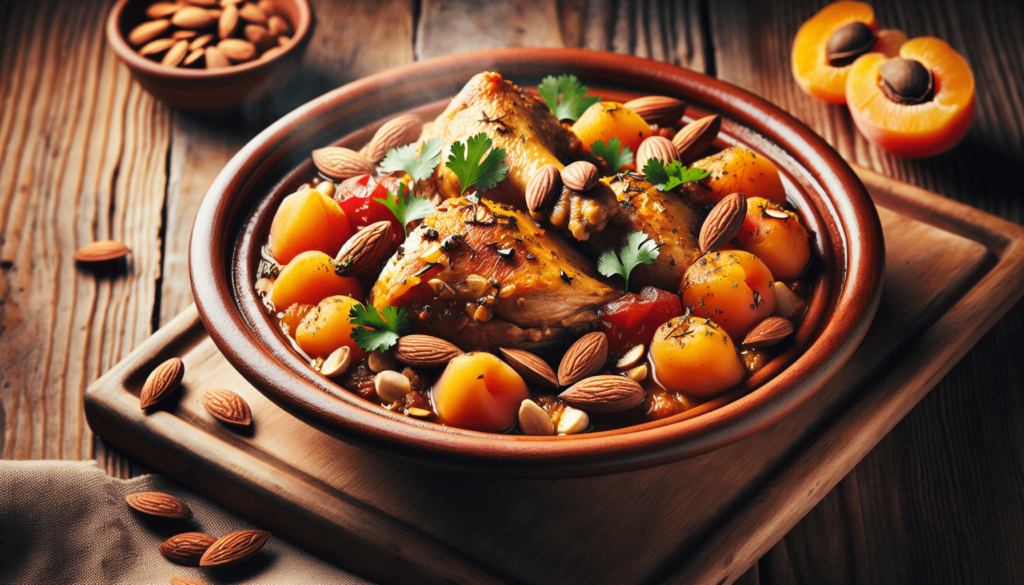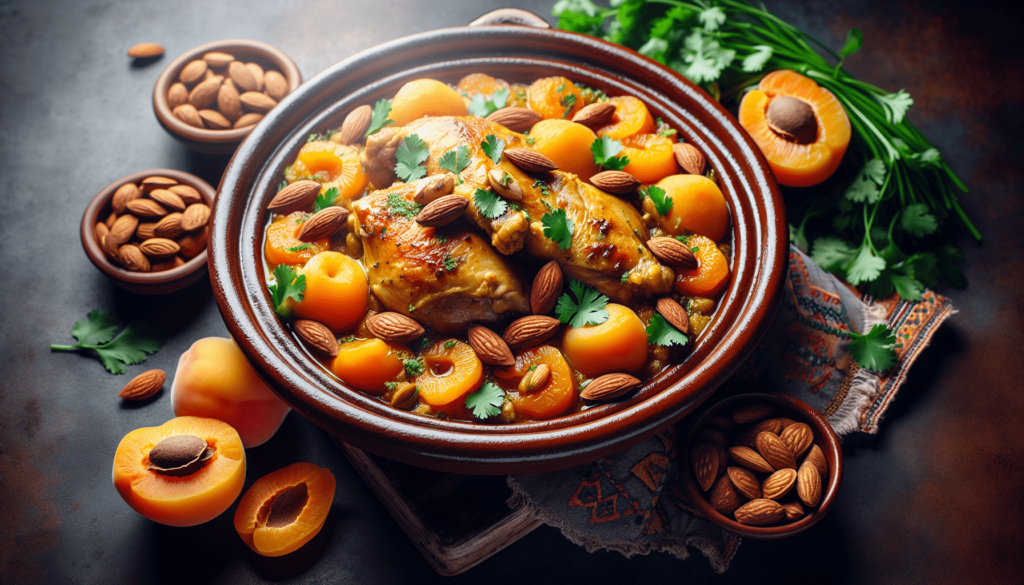Have you ever wanted to try your hand at cooking a dish that’s both comforting and bursting with flavor, straight from the heart of Moroccan cuisine? If you’re searching for something unique yet accessible, the Chicken Tagine might just be the perfect recipe to add to your culinary repertoire. This dish is an exquisite blend of savory and sweet, brought together by a symphony of spices that dance around tender chicken, all slowly simmered to perfection.

What is Chicken Tagine?
Chicken Tagine is a classic Moroccan dish that is traditionally cooked in a tagine pot, which is where its name originates. The tagine pot is a conical earthenware vessel that helps lock in moisture and enhances the flavor profile of the dish. The unique shape of the pot allows for circular heat distribution, ensuring that your dish is cooked evenly and stays succulent. While having a tagine pot is ideal, you can also prepare this dish in a heavy-based, covered pot or a Dutch oven if you don’t have one on hand.
The Origins of Tagine
The history of tagine is as rich and layered as the dish itself. It dates back to the Berbers of North Africa, who used the unique vessel to prepare slow-cooked dishes. Over time, it has become a signature of Moroccan cuisine, evolving with various regional adaptations. The technique of slow cooking allows the spices and ingredients to meld together, creating a harmony of flavors that is distinctive to Moroccan stews.
The Essential Ingredients
Creating an authentic Chicken Tagine involves gathering a variety of unique and flavorful ingredients. Here’s a rundown of what you’ll need and why each element is crucial to achieving the taste that makes this dish so special:
Chicken
You’ll want to use bone-in, skin-on chicken pieces for the best results. The bones add depth to the sauce, while the skin helps retain moisture. You can use a whole chicken cut into pieces, or just thighs and drumsticks as these cuts have more flavor and are less likely to dry out during cooking.
Spice Blend
No Chicken Tagine would be complete without its aromatic spices. Common seasonings include:
- Cumin: Adds a warm, earthy flavor.
- Coriander: Offers a citrusy note.
- Turmeric: Provides a golden color and subtle bitterness.
- Cinnamon: Infuses sweetness and warmth.
- Ginger: Delivers a gentle kick of heat and freshness.
- Paprika: Imparts a mild heat and a deep red hue.
Aromatics
Aromatics like onion and garlic are foundational to building the dish’s aroma and flavor. They are sautéed until golden to release their sweetness and depth.
Preserved Lemons and Olives
Preserved lemons give the tagine its signature tangy flavor, while olives add a salty bite. If preserved lemons are unavailable, you can substitute with lemon zest and a bit of lemon juice, but the unique taste of preserved lemons is worth seeking out.
Dried Fruits
Dried fruits like apricots or raisins add a sweet contrast that balances the savory and acidic notes of the dish.
Vegetables
Common additions can include carrots, sweet potatoes, or squash for more texture and sweetness.
Broth or Stock
A small amount of chicken broth or stock helps in simmering the chicken and vegetables together while creating a rich sauce.
Fresh Herbs
Cilantro and parsley are typically used to garnish the tagine, adding a fresh finish and a pop of color.
Step-by-Step Cooking Instructions
Now that you have your ingredients ready, let’s walk through the step-by-step process to bring your Chicken Tagine to life.
Preparing the Marinade
- Mix the Spices: In a bowl, combine your spices—cumin, coriander, turmeric, cinnamon, ginger, and paprika—along with salt and a bit of olive oil to create a paste.
- Coat the Chicken: Rub this paste all over your chicken pieces ensuring it’s evenly coated. Let it marinate for at least one hour, or overnight in the fridge for deeper flavor penetration.
Cooking the Tagine
- Saute Aromatics: In your tagine pot or chosen cooking vessel, heat some olive oil over medium heat. Add the chopped onions and garlic, sautéing until translucent and fragrant.
- Brown the Chicken: Increase the heat slightly, add the marinated chicken skin side down to the pot, and brown for a few minutes on each side.
- Layer the Ingredients: Scatter the preserved lemons, olives, and dried fruits around the chicken. Add any vegetables you’re using, arranging them around the chicken.
- Add the Broth: Pour in enough chicken broth or stock to cover the base of the pot but not submerge the chicken. This ensures everything stays juicy without drowning the ingredients.
- Simmer Slowly: Cover the pot and reduce the heat to low. Allow it to simmer slowly for about 45 minutes to 1 hour, until the chicken is tender and the aromas fill your kitchen.
Finishing Touches
- Check the Seasoning: Taste the sauce and adjust the seasoning as needed.
- Garnish: Just before serving, sprinkle freshly chopped cilantro and parsley over the dish for a pop of color and added freshness.

Tips for Perfecting Your Tagine
Creating a Chicken Tagine might seem daunting at first, but these simple tips will help you achieve the best possible results.
Cooking Vessels
While the tagine pot is traditional, using a Dutch oven or heavy-based pot can give you similar results if you ensure it’s tightly covered to trap steam.
Spice Adjustments
Feel free to tweak the spice blend to suit your tastes. If you prefer more heat, consider adding a touch of chili powder or cayenne.
Serving Suggestions
Chicken Tagine is best enjoyed with a side of couscous or bread to mop up the flavorful sauce. A side salad of mixed greens, olives, and a light vinaigrette pairs perfectly with the richness of the dish.
The Cultural Significance
In Moroccan culture, a tagine is not just a meal, but a symbol of hospitality and community. Preparing and sharing this dish is an experience meant to be savored with family and friends. The slow-cooked nature of the tagine is reflective of the unhurried, warm hospitality of Moroccan culture where meals are more than just sustenance—they’re an event.
FAQ: Common Questions about Chicken Tagine
Can I prepare Chicken Tagine in advance?
Yes, in fact, Chicken Tagine often tastes better the next day as the flavors have time to meld. Prepare the tagine the day before, chill it, and reheat gently before serving.
Can I substitute chicken with another protein?
Certainly. While chicken is traditional, lamb or beef can be used. Bear in mind that these meats may require a longer cooking time to become tender.
Are preserved lemons essential?
Preserved lemons are a hallmark of Moroccan cuisine, bringing a unique salty-sour depth to the dish. If unavailable, use regular lemon zest and juice, but for an authentic experience, try making or sourcing preserved lemons.
How can I store leftovers?
Leftovers can be stored in an airtight container in the fridge for up to four days. Reheat gently on the stove, adding a splash of broth if needed to loosen the sauce.
Final Thoughts
Embracing the art of cooking a Chicken Tagine is not just about making a dish—it’s about embarking on a culinary journey. Each step, ingredient, and aroma contributes to a final creation that is both nourishing to the body and soul. Whether you’re cooking for an intimate dinner or a lively gathering, this dish promises to fill your home with warmth and your table with joy. Enjoy the process, savor the flavors, and share the experience with those you love.
Some of the links on this site are affiliate links, which means I may earn a small commission if you click on them and make a purchase, at no additional cost to you. As an Amazon Associate, I earn from qualifying purchases.



